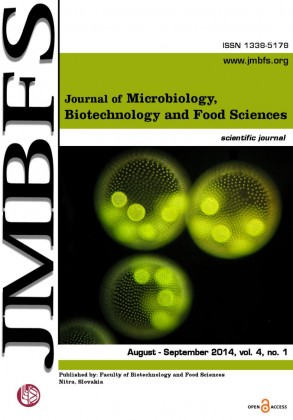ANTIMICROBIAL ACTIVITY OF NONTRADITIONAL PLANT POLLEN AGAINST DIFFERENT SPECIES OF MICROORGANISMS
DOI:
https://doi.org/10.15414/jmbfs.2014.4.1.80-82Keywords:
Nontraditional plant pollen, pathogenic bacteria, microscopic filamentous fungi, antimicrobial activityAbstract
The aim of this study was to detect the antimicrobial activity of four plant pollen samples to pathogenic bacteria, microscopic fungi and yeasts. Pollens of dogwood common (Cornus mas), ray mountain (Secale strictum spp. strictum), pumpkin rape (Cucurbita pepo var. styriaca) and grape vine (Vitis vinifera) were collected in 2010 in Slovakia. The antimicrobial effects of the four nontraditional plant pollens were tested using the agar well diffusion method. For extraction, 70% ethanol (aqueous, v/v) was applied. Antimicrobial susceptibility of five different strains of bacteria - three gram positive (Listeria monocytogenes CCM 4699, Pseudomonas aeruginosa CCM 1960, Staphylococcus aureus CCM 3953) and gram negative (Salmonella enterica CCM 4420, Escherichia coli CCM 3988), as well as three different strains of microscopic fungi, Aspergillus fumigatus, Aspergillus flavus, Aspergillus niger, and three different strains of yeasts Candida albicans, Geotrichum candidum and Rhodotorula mucilaginosa, were examinated. L. monocytogenes was the most sensitive among bacteria to the three ethanol extracts of plant pollen after 24 hours of inoculation, A. flavus and C. albicans were the most sensitive microscopic fungi and yeast species, respectively.Downloads
Download data is not yet available.
Downloads
Published
2014-08-01
How to Cite
KaÄániová, M., Terentjeva, M., Petrová, J., Hleba, L., Shevtsova, T., Kluz, M., Rožek, P., & VukoviÄ, N. (2014). ANTIMICROBIAL ACTIVITY OF NONTRADITIONAL PLANT POLLEN AGAINST DIFFERENT SPECIES OF MICROORGANISMS. Journal of Microbiology, Biotechnology and Food Sciences, 4(1), 80–82. https://doi.org/10.15414/jmbfs.2014.4.1.80-82
Issue
Section
Microbiology
License
Copyright (c) 2014 Miroslava KaÄániová, Margarita Terentjeva, Jana Petrová, Lukáš Hleba, Tetiana Shevtsova, Maciej Kluz, Przemyslaw Rožek, Nenad VukoviÄ

This work is licensed under a Creative Commons Attribution 4.0 International License.
All papers published in the Journal of Microbiology, Biotechnology and Food Sciences are published under a CC-BY licence (CC-BY 4.0). Published materials can be shared (copy and redistribute the material in any medium or format) and adapted (remix, transform, and build upon the material for any purpose, even commercially) with specifying the author(s).





